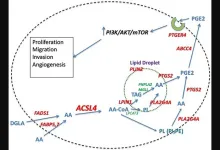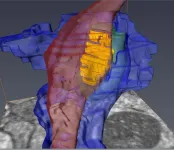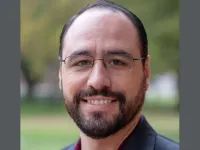(Press-News.org) For years, research and therapies for allergic asthma have been focused largely on targeting the inflammatory cytokines in the body that react to allergens and cause overproduction of mucus, wheezing and difficulty breathing. Commonly prescribed drugs like Omalizumab, Dupilumab, Mepolizumab and Reslizumab lower or block the various cytokines and antibodies responsible for the asthmatic response, but they work after a patient’s airway inflammation is well underway.
Dr. Tigno-Aranjuez wanted to find a new approach to keep allergen receptors from reacting in the first place. So she utilized a technique called LRC-TriCEPS – which identifies receptors in cells — for a common allergen, house dust mite. The technology showed a cell protein called LMAN1 that had never before been recognized for having a role in the body’s allergen response.
Her findings were recently published in Cell Reports, her highest impact paper to date.
“When we first had this discovery, we wanted to know, ‘What is this protein? What is already known about LMAN1 as an allergen receptor?’ and the interesting thing was that people had not been paying much attention to this protein in the context of allergy or allergic asthma,” she said.
Before her discovery, LMAN1 was generally known as a cargo receptor – a protein that transports other proteins inside and outside the cell. However, Dr. Tigno-Aranjuez demonstrated that house dust mite allergens and LMAN1 can bind together on the cell surface to cause the inflammatory or allergic reaction. Her research further showed that the binding depended on specific mannose sugar structures on the house dust mite allergens. This discovery has tremendous potential since many other common allergens, including pollen and fungi, are mannosylated, or modified by the addition of mannose sugars.
“Our thinking is that this could potentially not just be restricted to dust mites because many other allergens are mannosylated, this could be a very broad receptor that recognizes many different allergens,” she explained. “If you are thinking in terms of potential therapy, by understanding how LMAN1 recognizes dust mites and the consequences of such recognition, you could apply this to many other settings, and that is what we are currently trying to explore.”
The National Institutes of Health also saw potential with the UCF research, having just awarded Dr. Tigno-Aranjuez a $1.5M R01 grant to see if LMAN1 has a role in the expression of other mannosylated allergens.
Dr. Tigno-Aranjuez’s research on LMAN1 is performed in collaboration with the Cleveland Clinic. Dr. Bin Zhang, Associate Professor at the Lerner Research Institute, serves as co-investigator on this study. Dr. Zhang is considered an expert in LMAN1.
“LMAN 1 has been largely known as a protein that is involved in transporting proteins from inside cells to the outside of cells,” explained Dr. Zhang. “This research is the first one to show an entirely new function of LMAN1, as a receptor to bring proteins, such as allergens, from outside of cells to the inside. This could open up a new pathway for treatment.”
With hundreds of thousands of allergic asthma cases in the United States every year, and many more worldwide, this research represents a step forward toward helping these patients.
“Asthma is so prevalent that sometimes, people think, ‘We’ve already got a lot of treatments, we’ve got it covered.’ The reality is that we could always use more options, we could always improve upon existing treatments.” Said Dr. Tigno-Aranjuez. “Many treatments can only be prescribed if you meet certain clinical criteria, many treatments are cost prohibitive, many are not covered by insurance. So any new treatment we can put forth that could potentially be a more universal treatment would always be an advance.”
Dr Tigno-Aranjuez and her team are now conducting research to confirm their hypothesis that other mannosylated allergens, such as pollen, are also recognized by LMAN1. If true, this could have broad implications in future therapies for many of the most common allergens.
Dr. Tigno-Aranjuez immigrated to the United States from the Philippines to conduct her graduate and postdoctoral training at Case Western University in Cleveland. She joined UCF in 2015 and focuses her research on immune signaling pathways involved in chronic inflammatory diseases such as asthma and Crohn’s disease.
END
UCF researcher’s innovative approach could redefine allergy treatment
For those suffering from allergies, especially allergic asthma, springtime can be dreadful. Fortunately, UCF researcher Dr. Justine Tigno-Aranjuez is making breakthroughs that could one day make many common allergies a thing of the past.
2023-06-14
ELSE PRESS RELEASES FROM THIS DATE:
ACSL4: Biomarker, mediator and target in quadruple negative breast cancer
2023-06-14
“ACSL4 has been demonstrated to play a pivotal role in both normal physiology as well as in a variety of disease states, including breast and other cancers.”
BUFFALO, NY- June 14, 2023 – A new review paper was published in Oncotarget's Volume 14 on June 12, 2023, entitled, “ACSL4: biomarker, mediator and target in quadruple negative breast cancer.”
Breast cancer is a heterogeneous disease for which effective treatment depends on correct categorization of its molecular subtype. ...
UTIA researchers find high risk to amphibians if fungal pathogen invades North America
2023-06-14
New research indicates the fungal pathogen Batrachochytrium salamandrivorans (Bsal) could be devastating to amphibian biodiversity if introduced to North America. Nature Communications published the findings June 5 from a group of researchers at the University of Tennessee Institute of Agriculture, the University of Massachusetts-Boston and Washington State University.
“We could see over 80 species of salamanders in the United States and 140 species in North America experience population declines if Bsal is introduced,” said Matt Gray, the lead author and professor of ...
New images capture unseen details of the synapse
2023-06-14
Scientists have created one of the most detailed 3D images of the synapse, the important juncture where neurons communicate with each other through an exchange of chemical signals. These nanometer scale models will help scientists better understand and study neurodegenerative diseases such as Huntington’s disease and schizophrenia.
The new study appears in the journal PNAS and was authored by a team led by Steve Goldman, MD, PhD, co-director of the Center for Translational Neuromedicine at the University of Rochester and the University of Copenhagen. The findings represent a significant technical achievement ...
New UCF project launched to engage a diverse, new generation of researchers to aid aging populations
2023-06-14
ORLANDO, June 14, 2023 — The number of older adults in the U.S. population is growing, expecting to nearly double by 2060, and becoming more diverse with racial and ethnic minority populations projected to increase by 105% by 2040.
“As a society, we’re not ready for that,” says Norma Conner, a professor in the University of Central Florida’s College of Nursing. “We need to be cognizant of the large population of older adults that is going to be ours to care for, and we need to have a better understanding that reflects them.”
To ...
Stanford Medicine and Stanford Institute for Human-Centered Artificial Intelligence announce RAISE-Health, a responsible AI initiative
2023-06-14
Responding to rapid advances in artificial intelligence and the urgent need to define its responsible use in health and medicine, Stanford Medicine and the Stanford Institute for Human-Centered Artificial Intelligence (HAI) today announced the launch of RAISE-Health (Responsible AI for Safe and Equitable Health). This pioneering initiative seeks to address critical ethical and safety issues surrounding AI innovation and help others navigate this complex and evolving field.
Co-led by Stanford School ...
Scientists discover small RNA that regulates bacterial infection
2023-06-14
People with weakened immune systems are at constant risk of infection. Pseudomonas aeruginosa, a common environmental bacterium, can colonize different body parts, such as the lungs, leading to persistent, chronic infections that can last a lifetime – a common occurrence in people with cystic fibrosis.
But the bacteria can sometimes change their behavior and enter the bloodstream, causing chronic localized infections to become acute and potentially fatal. Despite decades of studying the transition in lab environments, how and why the switch happens in humans has remained unknown.
However, researchers ...
Making immunotherapy safer
2023-06-14
Researchers at the University of Houston are working to make T-cell immunotherapy safer, developing a tool called CrossDome, which uses a combination of genetic and biochemical information to predict if T-cell immunotherapies might mistakenly attack healthy cells.
T-cell based immunotherapies hold tremendous potential in the fight against cancer and infectious diseases, thanks to their capacity to specifically target diseased cells, including cancer metastasis. Nevertheless, this potential has been tempered with safety concerns regarding ...
Eyeing the brain: Predicting cerebrovascular diseases with retinal imaging
2023-06-14
The brain is one of the most metabolically active organs in the human body. Although it represents only about 2 percent of the human body’s weight, it receives 15 to 20 percent of the body’s total blood supply. Disrupted blood flow to the brain over a long period of time, a condition known as “chronic cerebral hypoperfusion” (CCH), can lead to serious cerebrovascular diseases such as white matter disease.
CCH manifests as lesions in the white matter, a brain region vulnerable to problems with blood supply. Unfortunately, CCH has no available cure. An early diagnosis by visualizing the microvascular changes in the brain that occur prior to lesion ...
Phone Menu Test Detects Who May Be at Risk of Alzheimer’s Disease
2023-06-14
A new study by investigators from Mass General Brigham has found that a brief, simulated task of navigating a phone menu can detect the earliest changes in daily functioning in people at risk of developing Alzheimer’s disease. Investigators found that an older adult’s performance on the test, which can be completed in a matter of minutes, was associated with the hallmarks of Alzheimer’s disease pathology, including amyloid and tau depositions in the brain. The findings, which were published in the Journal of Alzheimer’s Disease, could help inform prevention trials testing treatments for Alzheimer’s disease before ...
When local economic inequality is high, the rich tend to be more generous
2023-06-14
Rich individuals living in communities with greater levels of economic inequality tend to be more generous with charitable giving and prosocial behaviors, according to a study published June 14, 2023 in the open-access journal PLOS ONE by Joel H. Suss from the London School of Economics & Political Science and Bank of England, UK.
Many studies have attempted to assess whether the rich are more or less generous than the poor, and whether this shifts depending on the starkness of economic inequality. Thus far, the results have been inconclusive. Previous work in this vein has been conducted at a macro level, using state, region, and country-level aggregated data. In this study, Suss ...
LAST 30 PRESS RELEASES:
Tracing the quick synthesis of an industrially important catalyst
New software sheds light on cancer’s hidden genetic networks
UT Health San Antonio awarded $3 million in CPRIT grants to bolster cancer research and prevention efforts in South Texas
Third symposium spotlights global challenge of new contaminants in China’s fight against pollution
From straw to soil harmony: International team reveals how biochar supercharges carbon-smart farming
Myeloma: How AI is redrawing the map of cancer care
Manhattan E. Charurat, Ph.D., MHS invested as the Homer and Martha Gudelsky Distinguished Professor in Medicine at the University of Maryland School of Medicine
Insilico Medicine’s Pharma.AI Q4 Winter Launch Recap: Revolutionizing drug discovery with cutting-edge AI innovations, accelerating the path to pharmaceutical superintelligence
Nanoplastics have diet-dependent impacts on digestive system health
Brain neuron death occurs throughout life and increases with age, a natural human protein drug may halt neuron death in Alzheimer’s disease
SPIE and CLP announce the recipients of the 2025 Advanced Photonics Young Innovator Award
Lessons from the Caldor Fire’s Christmas Valley ‘Miracle’
Ant societies rose by trading individual protection for collective power
Research reveals how ancient viral DNA shapes early embryonic development
A molecular gatekeeper that controls protein synthesis
New ‘cloaking device’ concept to shield sensitive tech from magnetic fields
Researchers show impact of mountain building and climate change on alpine biodiversity
Study models the transition from Neanderthals to modern humans in Europe
University of Phoenix College of Doctoral Studies releases white paper on AI-driven skilling to reduce burnout and restore worker autonomy
AIs fail at the game of visual “telephone”
The levers for a sustainable food system
Potential changes in US homelessness by ending federal support for housing first programs
Vulnerability of large language models to prompt injection when providing medical advice
Researchers develop new system for high-energy-density, long-life, multi-electron transfer bromine-based flow batteries
Ending federal support for housing first programs could increase U.S. homelessness by 5% in one year, new JAMA study finds
New research uncovers molecular ‘safety switch’ shielding cancers from immune attack
Bacteria resisting viral infection can still sink carbon to ocean floor
Younger biological age may increase depression risk in older women during COVID-19
Bharat Innovates 2026 National Basecamp Showcases India’s Most Promising Deep-Tech Ventures
Here’s what determines whether your income level rises or falls
[Press-News.org] UCF researcher’s innovative approach could redefine allergy treatmentFor those suffering from allergies, especially allergic asthma, springtime can be dreadful. Fortunately, UCF researcher Dr. Justine Tigno-Aranjuez is making breakthroughs that could one day make many common allergies a thing of the past.






